There is a ruined house on the outskirts of Hanoi, Vietnam that is always with me. It periodically pops up in my dreams, drifts across my daydreaming mind, tugs at my imagination. This house is not really a house, its a French colonial mansion, its proportions beautiful, it situation elegant, its fate tragic. The house of my dreams sits back from the road, (actually the QL1A highway which runs roughly from Hanoi to the Chinese-Vietnam border 2300kms away), it has pillared porticos, bay windows, spacious balconies on all sides, many many shuttered sash windows. Its facade is faded yellow, its shutters azure blue. Its sits magnificently in its unkempt gardens, its dignity defiantly intact despite its structural decay. I’ve only ever seen the house of my dreams twice in real life, but sometimes I feel I could move heaven and earth to make it mine.
If you think of Vietnam what comes to mind? For most the Vietnam War, Forrest Gump, The Quiet American; for the rest an exotic and undiscovered tourist destination (although its not so undiscovered anymore!). But did you know that Vietnam has some of the most exquisite French colonial architecture in Asia? But perhaps not for long. French colonial villas, shops, and other buildings are being torn down at an alarming rate to make way for new developments with little or no regard for the heritage that is being lost. And Vietnam is not the only culprit. Colonial architecture in Cambodia and Laos is suffering the same fate.
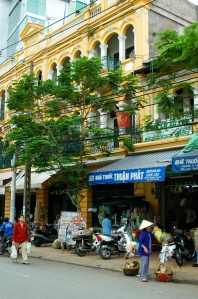
All you need to when strolling around central Saigon is look up, and behind the chaos you’ll see many beautiful colonial French shop fronts.
Nine years ago I called Saigon home. It was chaotic and crazy and totally addictive. Poised between tradition and modernity, with shopping malls and high rise apartment buildings emerging from the swampy, cratered, war scarred outskirts of the city, it seemed a crucible of possibility. I’m not kidding. Next to our compound was a crater made by American bombers during the Vietnam War, today there’s a fancy mall, luxury apartments and multinational companies’ headquarters. That’s progress. Except the old French quarters are also bearing the brunt of this obsession with modernity. One by one colonial era and Art Deco buildings are brought crashing down, and are replaced with soulless high rises. One of my favourite things to do on weekends was to jump on my vespa and explore the city with my camera slung over my shoulder. One day I came across a dilapidated, utterly abandoned colonial villa. Its wrought iron gates were encapsulated in vines, its windows were broken, its shutters unhinged, its plasterwork cracked, its yellow paint peeling…and it was one of the most beautiful buildings I’d ever seen (second to my dream mansion in Hanoi only in size). I gingerly plucked my way through its overgrown boundary (totally trespassing of course), and nonchalantly strolled around the side of the mansion trying to look as though I had the authority to be doing so. The verandah was deep and blissfully shaded, original victorian tiles intact. Taking a deep breath I peered in through a glassless side window, half expecting a bat, rat or angry squatter to come flying out at me, but all was still. Of course the villa was in a pitiable state: water damaged, smelly, stripped down to its bare bones, but as I glanced around I realised what exquisite bones they were. High high ceilings, generously proportioned rooms, cornicing, wooden floors, picture rails. The elegance still shined through the muck. From that day on I began to be on the look-out for French colonial villas, and boy did I find them!
The French swooped in and made Vietnam their own in 1858/9, and by 1893 had added Cambodia and Laos to form French Indochina. Independence was won in 1945, but the French only formally withdrew in 1954. In those 96 years the face of Indochina was changed, literally. The French infused the region with their architecture, their wide tree-lined boulevards, and their food (Banh Mi or French baguette is as good in Vietnam as in France!). Buildings were made to combat the tropical heat and rain with deep verandahs, high ceilings, shady inner courtyards, and generous overhangs. The problem these days is that these buildings are not glamourous…or at least not in the modern sense. They are not tall, or made of glass, or built to resemble a vegetable/sail/maze, and their most damning failure is that they don’t epitomise progress. They are hark-backs to a darker time, to a history thrown by the wayside, cruelly trodden down by the merciless marching on of time. Too dramatic? Probably. But still true.
The destruction is driven by economic growth, modernisation at all costs, the heady throb of progress. Hoang Dao Kinh, a specialist in the preservation of Hanoi’s cultural and historical heritage, said out of more than one thousand French villas in the Vietnamese capital, only a few hundred remain in the original colonial style. Many of the owners of the houses are not interested in restoration, and sell to the highest bidder, which is usually a developer. This is a short-term pattern of thinking driven by sheer profit. Cambodia’s capital city Phnom Penh used to known as the Pearl of Asia thanks to its beautiful tree lined boulevards, French villas and manicured gardens, but it is estimated that 30% of these historical buildings have been destroyed in the last 15 years. In Vietnam however there are success stories, namely Dalat and Hoi An in the northern part of the country. In these towns time has stood still and the unique mix of French and Vietnamese cultures is what sets them apart. Tourists flock to meander through the impeccably preserved towns, relax in colonial boutique hotels, and soak up the atmosphere of times gone by. The towns of Luang Prabang and Vientiane in Laos are a similar success story. These restored villas are a major tourist draw. They are a gift of history that should be capitalised on.
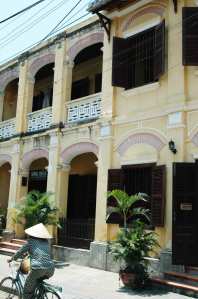
There are a few success stories in Vietnam and Laos where colonial architecture has been preserved, and the towns are now major tourist attractions.
What intrigues me about these colonial buildings is the social history they represent. They are the consequence of an invading force laying claim to an occupied landscape. How did the local Vietnamese families feel about the grand villas springing up all over their city? Did they see it as progress in the same way they see high rises as progress today? And what about the French diplomates and their wives and children who occupied these buildings? Did they miss home, did they adjust to their new lives in the Orient? Were they comforted by the familiar architecture? Think of the glittering parties, the conversations, the politics, the hopes, the fears, the realities experienced in these magnificent mansions and palaces, and you can’t help but be moved by their destruction and decay. And think of the interiors: flagstone floors, patterned victorian tiles, shuttered sash windows, gilt mirrors, sweeping staircases, soaring ceilings with ceiling roses and beautiful cornicing. It’s a graciousness and majesty that can’t be found in modern buildings today.
Progress is merciless, but cities are not like us: their past should define them, their history should impact their future. Just as strength should not be measured by the weights you can lift, nor power by how loud you can shout, so progress should not be measured by how modern or high a city’s skyline can be.
These before and after pictures of Vietnam give you a real sense of what is being lost.
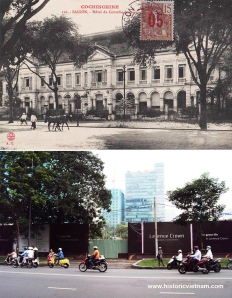
The Hôtel du Controleur financier building at 12 boulevard Norodom (Lê Duẩn), home to the city museum from 1917-1925 and demolished in 2010 to make way for the “Lavenue Crown” development. According to a 2011 article in Tuổi Trẻ newspaper, an architect convinced the authorities that the 1890s building was a fairly recent “faux-colonial” structure and therefore had no heritage value.
Thank you to the Saigon Cho Lon Then and Now Facebook page for the images of old Saigon, and also to www.historicvietnam.com.
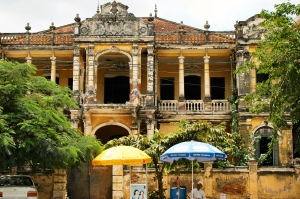
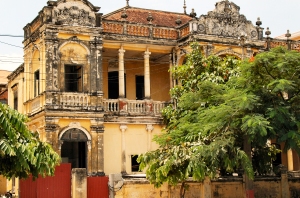
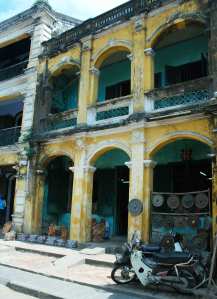
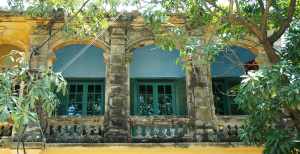
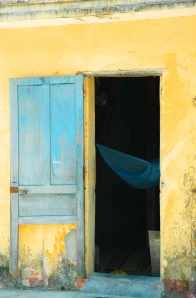
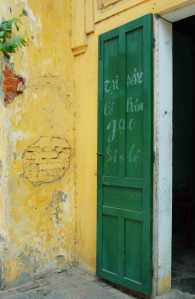
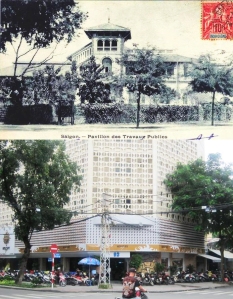
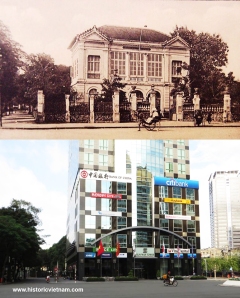
Such a shame. Economics rule, so it seems. Often renovation and upkeep costs influence decisions made by architects.
LikeLike